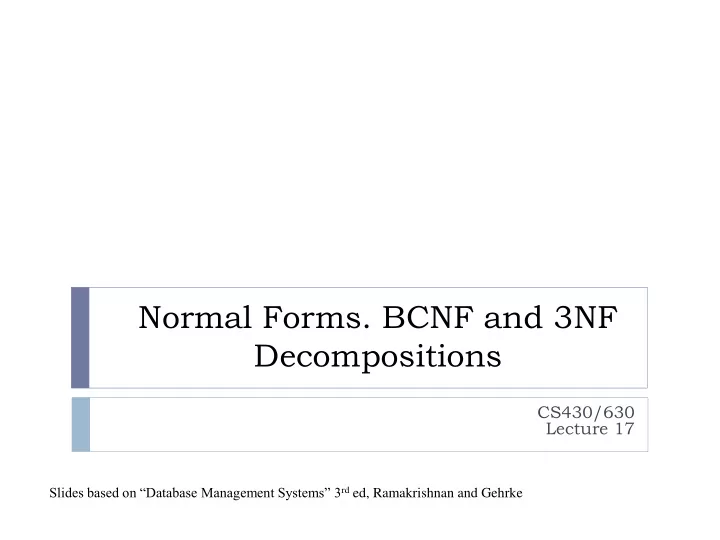

Normal Forms. BCNF and 3NF Decompositions CS430/630 Lecture 17 Slides based on “Database Management Systems” 3 rd ed, Ramakrishnan and Gehrke
Decomposition of a Relation Schema A decomposition of R replaces it by two or more relations Each new relation schema contains a subset of the attributes of R Every attribute of R appears in one of the new relations E.g., SNLRWH decomposed into SNLRH and RW Decompositions should be used only when needed Cost of join will be incurred at query time Problems may arise with (improper) decompositions Reconstruction of initial relation may not be possible Dependencies cannot be checked on smaller tables
Lossless Join Decompositions Decomposition of R into X and Y is lossless-join if: X Y ( r ) ( r ) = r X Y It is always true that r ( r ) ( r ) In general, the other direction does not hold! If it does, the decomposition is lossless-join. It is essential that all decompositions used to deal with redundancy be lossless!
Incorrect Decomposition A B 1 2 4 5 Natural 7 2 Join A B C A B C 1 2 3 1 2 3 B C 4 5 6 4 5 6 7 2 8 2 3 7 2 8 5 6 1 2 8 2 8 7 2 3
Condition for Lossless-join The decomposition of R into X and Y is lossless-join wrt F if and only if the closure of F contains: X Y X, or X Y Y In particular, the decomposition of R into UV and R - V is lossless-join if U V holds over R.
Dependency Preserving Decomposition Consider CSJDPQV, C is key, JP C and SD P. Consider decomposition: CSJDQV and SDP Problem: Checking JP C requires a join! Dependency preserving decomposition (Intuitive): If R is decomposed into X and Y, and we enforce the FDs that hold on X, Y then all FDs that were given to hold on R must also hold Projection of set of FDs F : If R is decomposed into X, ... projection of F onto X (denoted F X ) is the set of FDs U V in F + ( closure of F ) such that U, V are in X.
Dependency Preserving Decompositions Decomposition of R into X and Y is dependency preserving if (F X U F Y ) + = F + Dependencies that can be checked in X without considering Y, and in Y without considering X, together represent all dependencies in F + Dependency preserving does not imply lossless join: ABC, A B, decomposed into AB and BC.
Normal Forms If a relation is in a certain normal form (BCNF, 3NF etc.), it is known that certain kinds of problems are avoided/minimized. Role of FDs in detecting redundancy: Consider a relation R with attributes AB No FDs hold: There is no redundancy Given A B: Several tuples could have the same A value If so, they’ll all have the same B value!
Boyce-Codd Normal Form (BCNF) F Relation R with FDs F is in BCNF if, for all X A in A X (called a trivial FD), or X contains a key for R The only non-trivial FDs allowed are key constraints BCNF guarantees no anomalies occur
Decomposition into BCNF Consider relation R with FDs F. If X Y violates BCNF, decompose R into R - Y and XY. Repeated application of this idea will give us a collection of relations that are in BCNF; lossless join decomposition, and guaranteed to terminate. e.g., CSJDPQV, key C, JP C, SD P , J S T o deal with SD P , decompose into SDP , CSJDQV. T o deal with J S, decompose CSJDQV into JS and CJDQV
Decomposition into BCNF CSJDPQV SD P CSJDQV SDP J S CJDQV JS In general, several dependencies may cause violation of BCNF. The order in which we “deal with” them could lead to very different sets of relations!
BCNF and Dependency Preservation In general, there may not be a dependency preserving decomposition into BCNF e.g., ABC, AB C, C A Can’t decompose while preserving first FD; not in BCNF
Third Normal Form (3NF) F Relation R with FDs F is in 3NF if, for all X A in A X (called a trivial FD), or X contains a key for R, or A is part of some key for R (A here is a single attribute) Minimality of a key is crucial in third condition above! If R is in BCNF, it is also in 3NF. If R is in 3NF, some redundancy is possible compromise used when BCNF not achievable e.g ., no ``good’’ decomposition, or performance considerations Lossless-join, dependency-preserving decomposition of R into a collection of 3NF relations always possible.
Decomposition into 3NF Lossless join decomposition algorithm also applies to 3NF To ensure dependency preservation, one idea: If X Y is not preserved, add relation XY Refinement: Instead of the given set of FDs F, use a minimal cover for F Example: CSJDPQV, JP C, SD P, J S Choose SD P , result is SDP and CSJDQV Choose J S, result is JS and CJDQV, all 3NF Add CJP relation
Summary of Schema Refinement BCNF: relation is free of FD redundancies Having only BCNF relations is desirable If relation is not in BCNF, it can be decomposed to BCNF Lossless join property guaranteed But some FD may be lost 3NF is a relaxation of BCNF Guarantees both lossless join and FD preservation Decompositions may lead to performance loss performance requirements must be considered when using decomposition
Recommend
More recommend